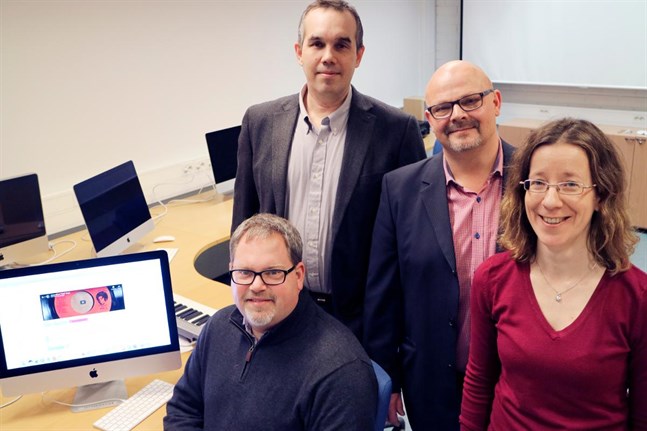The Notio Project focuses on developing new pedagogies and technologies for improving the teaching of music theory together within the creative music practices of songwriting and improvisation to improve music education in schools in Finland. This project is funded as a Bridging the Theory and Practice of Music through Educational Research and Technology research grant from the Åbo Akademi University Foundation, the University Foundation of Ostrobothnia, The Swedish Cultural Foundation and Konstsamfundet/The Arts Association Foundation (Finland). The MusEDLab is collaborating with PI Cecilia Björk (Åbo Akademi), Mats Granfors (Novia University of Applied Sciences), Jan Jansson (Vasa övningsskola) and Marcus Gustafsson (Åland Music Institute).
The Notio App allows the user to visualise, listen to, practice, and create music while building on a variety of scales and modes. The application combines a color xylophone, staff notation and a keyboard, and can be customized to display scale steps and chord extensions as well as note names in several languages and in the relative system. It includes a video window for playing music, preset tutorials and user-customized lessons. Anyone can use the app for free.
The app is currently being developed by Mats Granfors, Cecilia Björk and Alex Ruthmann together with Emelie Zawadzki (coding), Muriel Colagrande (graphic design), Joachim Högväg and Joachim Majors (UI & UX) and Guergana Tzatchkova (initial coding). We welcome your response during the development process! Please write to us at [email protected]
-----------------------------------------------------------------------------------------

Project Abstract
For students who are primarily interested in learning to play, sing and make their own music, the theory of music may seem abstract, far removed from reality, and even irrelevant. Even though music theory as a rigorous and autonomous academic discipline makes invaluable contributions to analytical knowledge, there have been repeated warnings by teachers, researchers and music professionals that the gap between theory and practice has become too wide, to the detriment not only of students’ motivation but also of musical culture and expertise (Cook, 2012; McPherson, Davidson & Faulkner, 2012; Strand & Larsen, 2011). In educational contexts, music theory runs the risk of becoming a stumbling block rather than being integrated organically with practical music-making so as to support and inspire learning and active musical practice. This challenge is shared by music educators globally (Johnson, 2014) and it is of great relevance and topicality in Finland, where renewed national core curricula for basic education and general upper secondary education emphasise that musical concepts should be taught and learnt in context and in connection with active music-making (Finnish National Board of Education, 2014, 2015).
In recent years, it has become possible to study cognitive and practice-related processes in music-making with highly technological methods. For instance, eye-tracking technique has been used to validate the postulate that experienced musicians have developed well-integrated, cross-modal representations of musical structure, enabling them to sight-read fluently and to anticipate motor difficulties (Drai-Zerbit, Baccino & Bigand, 2012). There is great opportunity for educational research in the emergence of new methods for bridging the theory and practice of music. However, if music education is to benefit from the new possibilities and insights, additional interdisciplinary research is required, using approaches that combine recent knowledge from education, music education, cognitive science, music performance, the humanities, and technology.
The purpose of this project is to investigate educationally relevant interactions between theoretical musical knowledge and practical musical skills. For example, we will study how awareness of tonality, modality, rhythmic subdivisions, and larger musical structure (phrase and form) relates bidirectionally to audible changes in fluency, confidence and expressivity in performance. Our goal is to produce knowledge which can support the development of innovative educational applications that are helpful and inspiring for music students and educators alike, and that can encourage a positive attitude towards music theory.